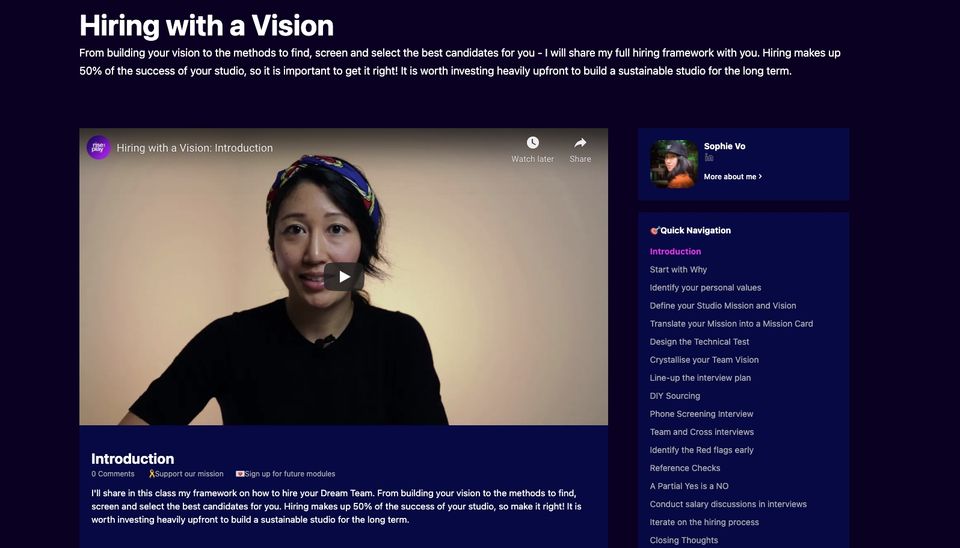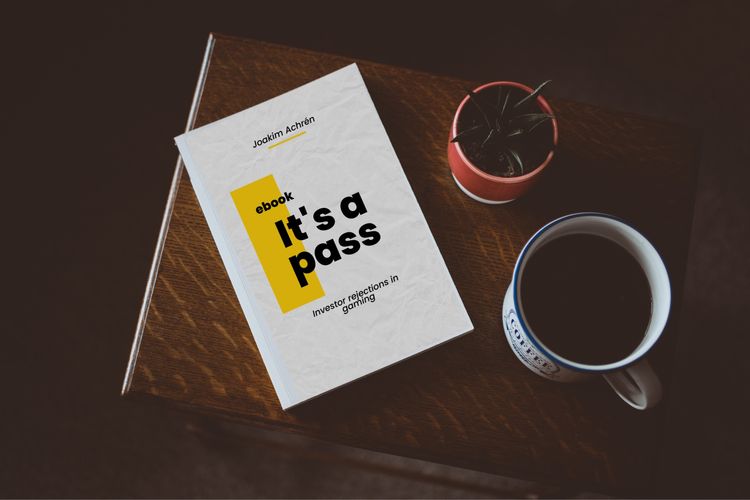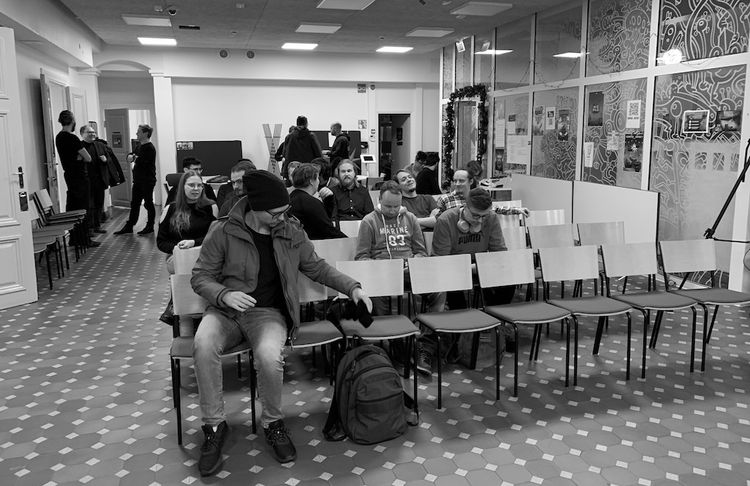Hiring for game studios — Masterclass review


Sophie Vo, Studio & Game Lead at Voodoo Berlin, has created a free masterclass for game studios, to learn how to hire people for the studio’s culture. The Masterclass is called Hiring with a Vision and you can find it from here.
On a high level, the course could be separated into three parts. I would call these as Part 1 which is “Game Studio Culture,” where Sophie talks about how you can discover what your culture is about, the values, and the vision and mission of the studio. Then part 2, the “From studio to team and individual level” which examines who the team is: a group of people brought together can identify their purpose in the studio, the team and their personal substance. Who you have already there and what kind of roles and people you will be looking for. Finally part 3, “The interview,” focuses on planning for hiring, how do plan for interviews, sourcing people for various sources, and then conducting interviews and making hiring decisions.
Let’s now look at each part separately.
Part 1: Game Studio Culture
Sophie’s masterclass starts with a video titled Start With Why. I’ve written about Simon Sinek’s famous concept of starting with why previously. You shouldn’t focus on the what (“We make PVP games!”), the how (“We revolutionize the way that PVP games are made!”) but on the purpose (“We believe in competition as a driver for human development. Our purpose is to reinvent competitive gameplay in video games.”)
The masterclass then explores personal values, as they help to understand your why. “What you care about as a person, as a professional, as a friend, what are your values in life? And how will they reflect in how you work, how you hire, and how you interact with others.”
Then the masterclass focuses on defining the game studio’s mission and vision. Sophie talks about vision being this dream that you may never accomplish or that it’s something that you dream about and you’ll never let go. Sophie’s vision: “My dream is to create valuable and unique game experiences for a broad audience who don’t consider themselves as traditional gamers, to leverage games as a powerful interactive medium, to convey meaningful stories, values and emotions, as developers, to our players.” Then mission, which is how will you execute the vision, your dream of the future? What are the steps, whatever things you will do, and you execute, you get as close as possible to the dream?
Part 2: From studio to team and individual level
How do you go from understanding the why and the vision and mission of your studio, to then having that work on the team and on the individual level?
In the sixth video, Sophie introduces a concept of Team Vision, which can differ from the studio vision, since the team can have their exclusive vision and mission that they are executing. Sophie shares her own team’s vision:
- 1. Growth Mindset: have a mindset for learning, growing, asking questions.
- 2. Intellectual Humility: Honoring and respecting other viewpoints. seeing the strength in collective intelligence.
- 3. Team Player: Caring for others, being in a team. You go for the win, but as a group.
- 4. Player-centric: We aren’t making games for ourselves, but for our players. Sophie hires people who love making games for others, creating a delight for the audience.
A key to having the right teams is to think about diversity in the team. Having different backgrounds, different ways of thinking, and differences in being explicit versus implicit in ways of working, and direct versus indirect in feedback giving.
The mission card, that was introduced earlier in the masterclass, help the team to define the roles of the team members, when it relates to the mission that they are on.
In video 4, there is an example provided on the mission card for artists: what Sophie expects from artists. Sophie uses it when she hires artists and uses it as the starting point when the artist starts, and when they do follow-ups later.
- 1. The mission
- 2. The artist’s mission inside the team
- 3. Expected outcomes
- 4. Team Attributes: what are the behaviour that I expect as well from an artist
Part 3: The interview
When you do hires, you first want to define the context: what is the role that you are hiring for. Second, who will do the hiring and the interviews. Sophie shares an example of an interview plan on the Masterclass.
Once you have a plan in place, you want to start sourcing candidates. Especially small studios won’t have their own talent acquisition managers, so how do you become one for your studio? Find where people hand out: Artists are in Discord communities, etc. List communities and spend time there.
When you reach out to people, make the messages personal. Don’t use a template as it will be seen as spammy. Spend the time to get to know who they are, what they’ve been doing, their interests, etc.
Before the actual interview, do phone screenings to reveal immediate red flags regarding fit, and if this is even a close enough match for who you are looking for. Sophie provides lots of great examples in video 9.
After you’ve cleared the candidate from the phone screen, you start the interviews. Do team interviews, peers outside of team interviewing, mix it up. Both the candidate and your team will gain a better feel on the fit if many people are involved. But do remember to identify the red flags early, so that you don’t waste people’s time. Video 11 talks only about these red flags.
When you’ve moved further into the process, only then start conducting reference checks as video 12 instructs. I’ve also written about reference checks on EGD before, you can also use some of our questions for your checks.
The masterclass ends with videos on how to make the hiring decision and what the compensation discussion could look like in a gaming studio hire.
Final thoughts
I highly recommend this masterclass from Sophie Vo. It will help you get past so many problems that you will bump into when you do the wrong hires. All that time, money and attention capital spent in the wrong place isn’t good for anyone.
To check out Sophie’s masterclass and more, you can visit her website by going here.
Here’s the link to my review on Sophie’s next Masterclass, Antifragile teams.
Did you enjoy this article?
Here’s some more articles you might like.





